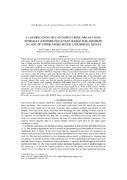| dc.description.abstract | Human-induced soil erosion and drastic change in land use practices have adversely infl uenced the land degradation
and surface runoff response in upper Njoro River catchment. The drainage area is approximately 127 km2.
Due to human activities, the land has been exposed to accelerated erosion and low land productivity, water
scarcity, decline in ground water recharge, siltation of Lake Nakuru and other sediment sinks. This study
was conducted to establish event-based risk areas for prioritized conservation within the catchment. Spatially
distributed soil erosion map was created as a ratio of sediment yield to sediment delivery ratio (SDR). Modifi ed
Universal Soil Loss Equation (MUSLE) integrated within a Geographical Information Systems environment
was used to create the sediment yield map. Spatial data layers for the MUSLE were derived from a 20-m
resolution Digital Elevation Model, soil property, land use maps and climatic data of the catchment. Land
use map was derived from Landsat imagery via its processing using Integrated Land and Water Information
Systems software. The results show that the spatially distributed soil erosion ranged from 0.06 to 0.51 t/ha
for a 43.2-mm rainfall event. Spatially distributed SDR ranged from 0.09 to 0.82, while the average SDR
for the whole catchment was 0.72. These values were derived using an empirical equation. A new contribution was made by developing spatially distributed slope length factor, SDR, runoff volumes, MUSLE
parameters and classifi ed erosion risk areas for prioritized catchment conservation. This means that the
event-based soil erosion classifi cation can be adopted for prioritized soil and water conservation within
Njoro catchment. | en_US |

